5.3 Performing advanced searches
If you need to specify multiple criteria when searching for users, groups, or task groups, you can use an advanced search. For example:
Last Name equals Smith AND Title contains Rep
An advanced search consists of one or more criteria groupings. When defining a new advanced search, you begin with one criteria grouping by default. Within a criteria grouping, you specify each criterion that you want and connect them (such as in the example above) by using these logical operations:
-
and
-
or
If you specify multiple criteria groupings (to control the order in which criteria are evaluated), you’ll use those logical operations to connect them too. For example, to perform an advanced search with the following criteria (two criteria groupings connected by an or):
(Last Name equals Smith AND Title contains Rep) OR (First Name starts with k AND Department equals Sales)
you would specify the following:
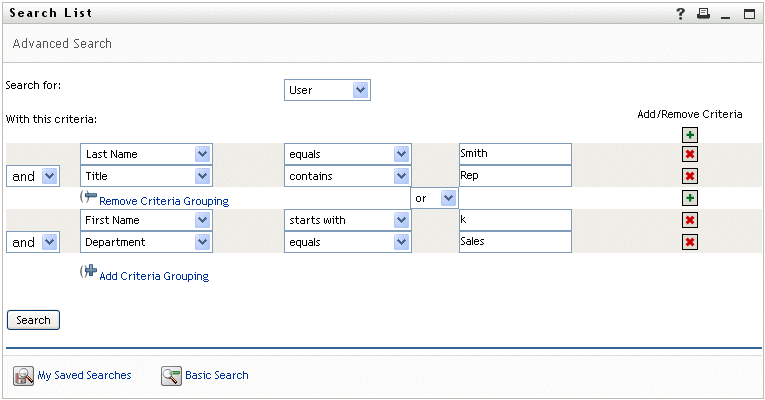
The result of this search is:
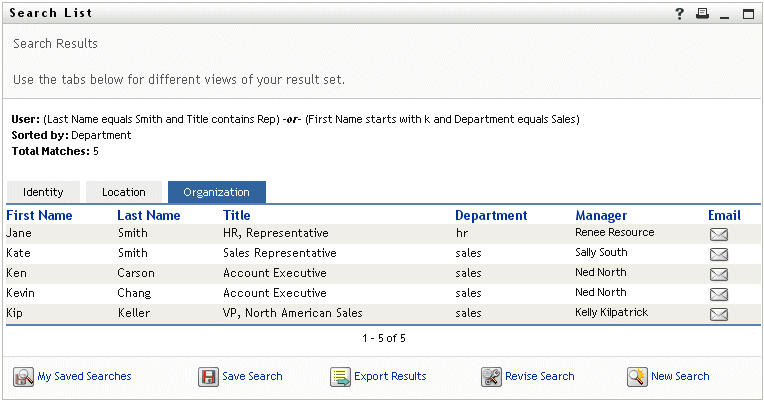
To perform an advanced search:
-
Go to the Directory Search page and click the New Search button (at the bottom of the page).
The Basic Search page displays by default.
-
Click the Advanced Search button (at the bottom of the page).
The Advanced Search page displays:
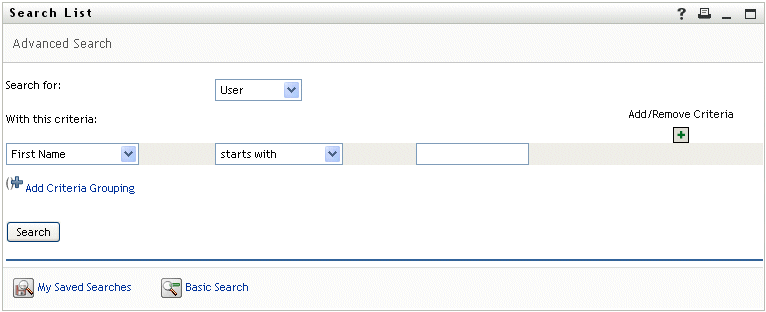
-
In the Search for dropdown, specify which type of information to find by selecting one of the following:
-
Group
-
Task Group
-
User
You can now fill in the With this criteria section.
-
-
Specify a criterion of a criteria grouping:
-
Use the dropdown on the left to select an attribute to search on. For example:
Last Name
The list of available attributes is determined by what you’re searching for (users, groups, or task groups).
-
Use the dropdown in the middle to select a comparison operation to perform against your chosen attribute. For example:
equals
For more information, see Section 5.3.1, Selecting a comparison operation.
-
Use the entry on the right to specify a value to compare against your chosen attribute. For example:
Smith
For more information, see Section 5.3.2, Specifying a value for your comparison.
-
-
If you want to specify another criterion of a criteria grouping:
-
Click the Add Criteria button on the right side of the criteria grouping:

-
On the left side of the new criterion, use the Criteria Logical Operator dropdown to connect this criterion with the preceding one; select either and or or.
-
Repeat this procedure, starting with Step 4.
HINT:To delete a criterion, click the Remove Criteria button to its right:

-
-
If you want to specify another criteria grouping:
-
Click Add Criteria Grouping:

-
Above the new criteria grouping, use the Criteria Grouping Logical Operator dropdown to connect this grouping with the preceding one; select either and or or.
-
Repeat this procedure, starting with Step 4.
HINT:To delete a criteria grouping, click Remove Criteria Grouping directly above it:

-
-
Click the Search button.
Your search results display.
To learn about what to do next, see Section 5.4, Working with search results.
5.3.1 Selecting a comparison operation
The list of comparison (relational) operations available to you in a criterion is determined by the type of attribute specified in that criterion:
5.3.2 Specifying a value for your comparison
The type of attribute specified in a criterion also determines how you specify the value for a comparison in that criterion:
Note that you don’t specify a value when the comparison operation is one of the following:
-
is present
-
is not present
Case in text
Text searches are not case-sensitive. You’ll get the same results no matter which case you use in your value. For example, these are all equivalent:
McDonald
mcdonald
MCDONALD
Wildcards in text
You can optionally use the asterisk (*) as a wildcard in your text to represent zero or more of any character. For example:
Mc*
*Donald
*Don*
McD*d
Using the Lookup, History, and Reset buttons
This section describes how to use these buttons:
|
Button |
What it does |
|---|---|
|
|
Looks up a value to use for a comparison |
|
|
Displays a History list of values used for a comparison |
|
|
Resets the value for a comparison |
To look up a user:
-
Click the Lookup button to the right of an entry (for which you want to look up a user):

The Lookup page displays:
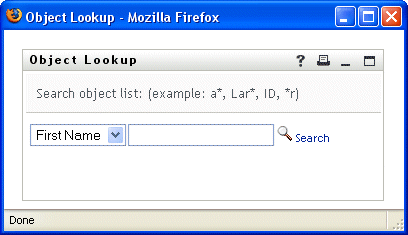
-
Specify search criteria for the user you want:
-
Use the dropdown list to choose whether the search is by First Name or Last Name.
-
In the textbox next to the dropdown, type all or part of the name to search for.
The search will find every name that begins with the text you type. It is not case-sensitive. You can optionally use the asterisk (*) as a wildcard in your text to represent zero or more of any character.
For instance, all of the following examples will find the first name Chip:
Chip chip c c* *p *h*
NOTE:A manager lookup will search only for users who are managers. A task-manager lookup will search only for users who are task managers.
-
-
Click Search.
The Lookup page displays your search results:
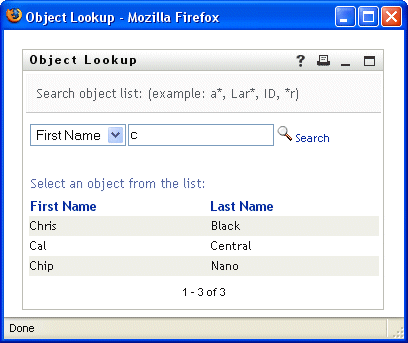
If you see a list of users that includes the one you want, go to Step 4. Otherwise, go back to Step 2.
HINT:You can sort the search results in ascending or descending order by clicking the column headings.
-
Select the user you want from the list.
The Lookup page closes and inserts the name of that user into the appropriate entry as the value to use for your comparison.
To look up a group or task group:
-
Click the Lookup button to the right of an entry (for which you want to look up a group or task group):

The Lookup page displays:
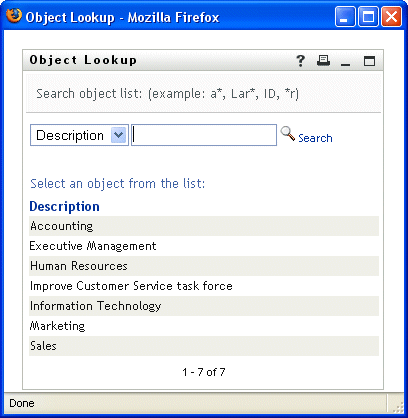
-
Specify search criteria for the group or task group you want:
-
In the dropdown list, your only choice is to search by Description.
-
In the textbox next to the dropdown, type all or part of the description to search for.
The search will find every description that begins with the text you type. It is not case-sensitive. You can optionally use the asterisk (*) as a wildcard in your text to represent zero or more of any character.
For instance, all of the following examples will find the description Marketing:
Marketing marketing m m* *g *k*
NOTE:A group lookup will search for groups and task groups. But a task-group lookup will search only for task groups.
-
-
Click Search.
The Lookup page displays your search results:
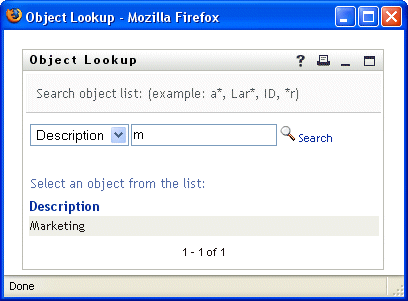
If you see a list of groups or task groups that includes the one you want, go to Step 4. Otherwise, go back to Step 2.
HINT:You can sort the search results in ascending or descending order by clicking the column heading.
-
Select the group or task group you want from the list.
The Lookup page closes and inserts the description of that group or task group into the appropriate entry as the value to use for your comparison.
To use the History list:
-
Click the History button to the right of an entry (whose previous values you want to see):

The History list displays, with values in alphabetical order:
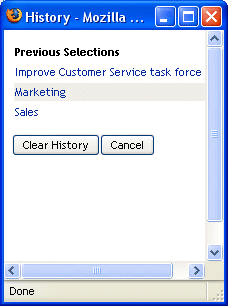
-
Do one of the following:
Using the Calendar button
The Calendar lets you pick a time value to use for a comparison (in date-time or date-only format).
To use the Calendar:
-
Click the Calendar button to the right of an entry (for which you want to pick a time):

The Calendar displays:
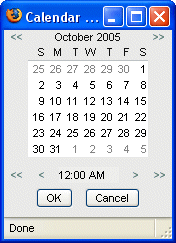
-
To specify a year, month, and day:
-
At the top of the Calendar, use the << and >> buttons to scroll to the year and month you want.
-
Select the day you want in that month.
-
-
To specify an hour and minute:
-
At the bottom of the Calendar, use the << and >> buttons to scroll to the hour you want.
-
Use the < and > buttons to scroll to the minute you want.
-
Click OK.
The Calendar closes and inserts the specified time into the appropriate entry as the value to use for your comparison.
-